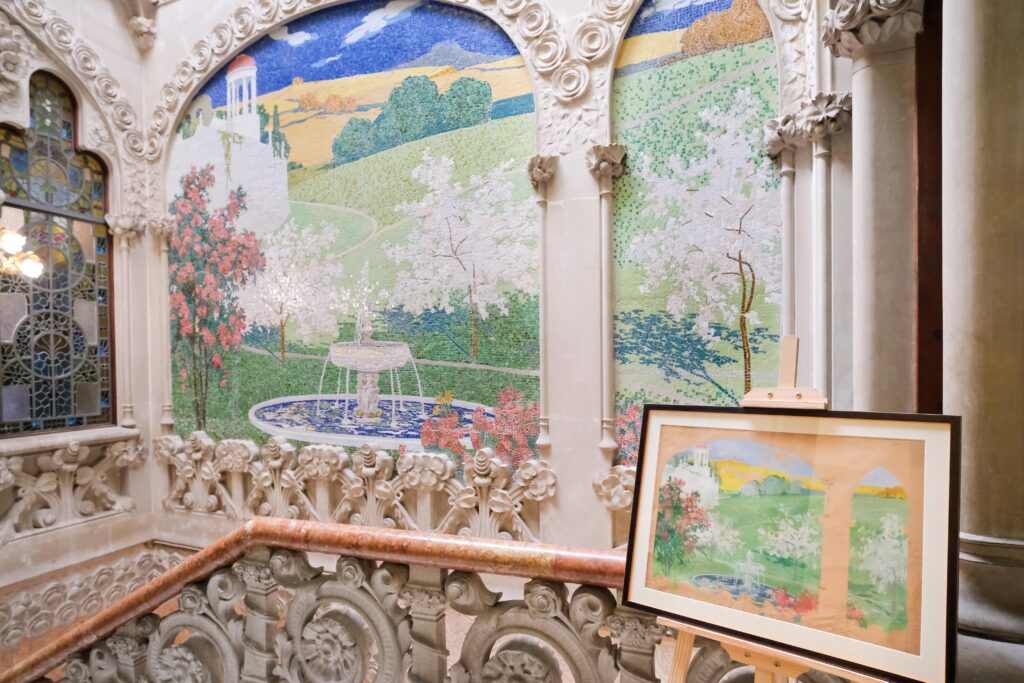- The owners of Casa Navàs have acquired the original painting by one of the most outstanding Catalan landscape painters.
A recent study has discovered that the large mosaic that presides over the entrance to Casa Navàs was painted by Joaquim Mir i Trinxet (1873-1940), one of the leading exponents of postmodernist painting, considered one of the best landscape painters of his generation and probably of all modern Catalan painting. The discovery was made by the art historian and mosaic specialist Marta Saliné i Perich, in collaboration with the art historian Jordi March Barberà, during the preparation of a conference for the 4th CoupDeFouet International Congress dedicated to the work of Lluís Domènech i Montaner.
This important discovery shows the magnificence that Art Nouveau and its architecture represented. Many craftsmen and artists were involved in the design of a space, such as the mosaic of the main staircase alone. Among them were some of the greatest artistic exponents of the time, such as the decorator Gaspar Homar and his collaborator Josep Pey or, as has now been revealed, Joaquim Mir, one of the leading names of the second wave of modernist or post-modernist painting.
This shows, on the one hand, that the Casa Navàs and its history are very much alive because there are still many aspects to be discovered and deciphered; and, on the other hand, that the modernist buildings of the period are total works of art, as they contain works by the best artists of the time.
The history of painting and mosaics
During the construction of the Casa Navàs, as he did with the rest of the buildings he designed, Domènech i Montaner himself had to draw a small sketch to be painted on the mosaic that was to preside over the main entrance to the house. In this case, he certainly wanted it to evoke a landscape with perspective to give depth to the space.
Subsequently, as the study reveals, the Barcelona painter Joaquim Mir i Trinxet was chosen to transfer the sketch to a painting on a reduced scale, adapted to the place where the mosaic was to be placed. During that period, between 1903 and 1906, Mir stayed at the Institut Pere Mata to recover from an accident he had suffered in Mallorca, a period in which he made friends with the cultural circles of Reus. During that period, between 1903 and 1906, Mir stayed at the Institut Pere Mata to recover from an accident he had suffered in Mallorca, a period in which he made friends with the cultural circles of Reus.
In the drawing, as if through a false window, a flowery landscape opens up to us in the form of a garden. We can see typical landscape elements of the area, such as the blooming almond trees that dominate the scene, a clear example of the importance of this fruit for the town at the beginning of the 20th century. Even so, the painting also shows influences from the Romantic gardens of the period, particularly the circular temple with columns, in the form of a tholos, crowned with a dome.
This reduced scale drawing was then transferred to Gaspar Homar (1870-1955), the most renowned interior decorator of Catalan Modernism and a close collaborator of Domènech i Montaner during the construction of various buildings such as the Casa Navàs, as it was, he who was commissioned to design and decorate the interiors. Josep Pey, a draftsman and painter who collaborated with Homar, transferred the drawing to a real scale and made some small variations with more precise details that Joaquim Mir’s gouache does not include, but which were necessary to transfer them to applied art.
The mosaic is made up of a set of tesserae that combine two types of materials. On the one hand, there is ceramic and, on the other, Venetian glass from Murano. The latter makes some of the details shine brightly in the light. Although it is not known who the mosaicist who made the mosaic was, it is known that Pey himself oversaw the direction and production. The installation was carried out by Josep Vidiella Ribot’s company, a building contractor from Reus located on the old road to Salou.
Casa Navàs acquires the original painting by Joaquim Mir
Marta Saliné identified Mir’s painting among the lots at an art auction held in Madrid. After contacting the auction house, together with Jordi March, they located the owner of the work, the collector and gallery owner Ramon Gento. He facilitated the historians to study the painting. Saliné and March informed the management of the Casa Navàs of the discovery, and the latter contacted the collector. Finally, a purchase agreement was formalized so that the painting could be returned to Casa Navàs, the place for which it was intended and created. For a few days, this painting will be exhibited at Casa Navàs so that the visiting public can enjoy it.
It is an atypical gouache, which does not occupy the whole of the canvas, as the limits marked by the columns and the upper arches projected on the wall of the main entrance are clearly visible. This proves that the work was drawn exclusively to be reproduced in this space.
Biography of Joaquim Mir i Trinxet
Joaquim Mir i Trinxet (Barcelona, January 1873 – Barcelona, 27 April 1940) was a Catalan painter who belonged to the second generation of modernist painters, also known as postmodernists.
Trained at Escola de la Llotja in Barcelona, his youth was determined by his artistic interest. He frequented the Quatre Gats, a café and exhibition hall that acted as the cultural center of the city of Barcelona, where he probably came into contact with a young Pablo Picasso. He was also a member of the “Colla del safrà” (Saffron group), along with such important artists as Isidre Nonell and Ramon Pitchot. In fact, this artistic group determines Mira’s first stage, with a painting of yellowish tones.
He went to Mallorca accompanied by Santiago Rusiñol, and it was there that he discovered his full potential in terms of color and light in painting. Mir is considered a painter close to the Impressionist style, although he never considered himself as such. His obsession was with the expression of light, a fact that made him a pioneering artist in our land, approaching an abstract conception of painting at the beginning of the 20th century.
Among his most important works is La catedral dels pobres (1898), from the artist’s youth, interesting because it shows the initial stage of construction of Gaudí’s church. Also notable are Coves de Mallorca (1903), decorations made for Puig i Cadafalch’s Casa Trinxet, and Poble escalonat (1909), an example of his work in Baix Camp as a great landscape and light painter.
Although he did not spend time as an apprentice in Paris or Rome, he did spend time in Madrid, where in 1899 he won second prize at the National Exhibition of Fine Arts. Among other cities, he exhibited his work in Venice, Amsterdam, New York, Washington, and Buenos Aires.





